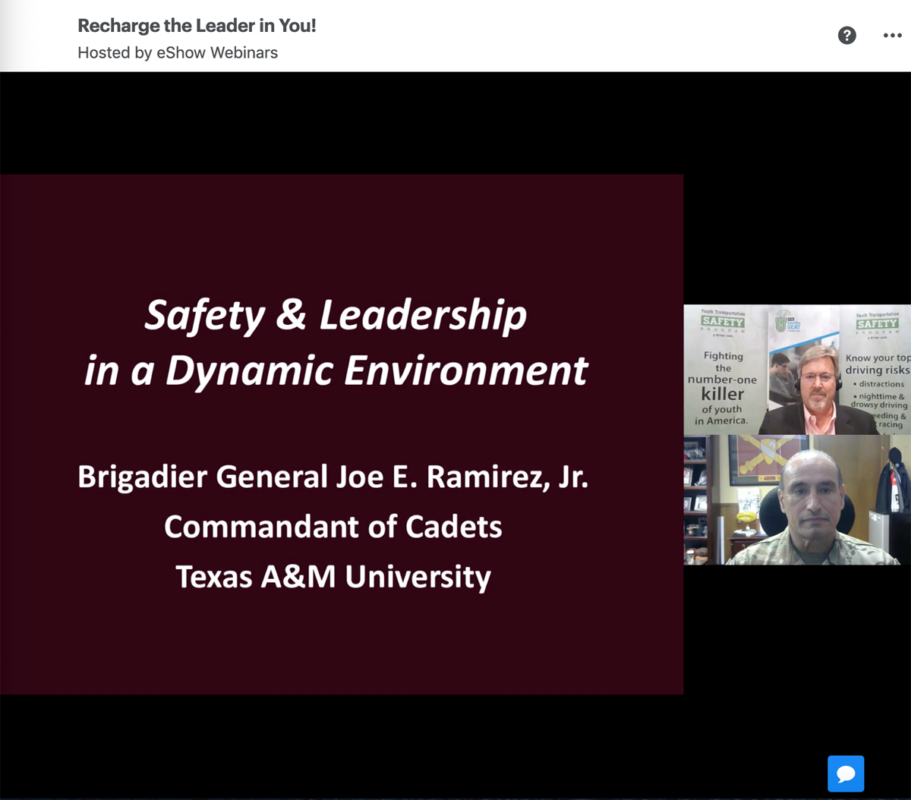
The Texas A&M Transportation Institute’s (TTI’s) U in the Driver Seat (UDS) education and outreach program held its virtual 2020 UDS Symposium Oct. 7–9. Now in its eighth year, the symposium raises awareness about the leading cause of death for young adults ages 18–25 — traffic crashes. This year’s theme was “recharge to save lives on our roads.”
The UDS program was created to reduce the number of impaired driving injuries and deaths of college-aged students. This peer-to-peer initiative was inspired by the highly successful Teens in the Driver Seat® program, which began nearly 20 years ago and is aimed at reducing the large number of teen injuries and deaths due to car crashes. The UDS program is the first organization of its kind to host a virtual traffic safety event for both students and traffic safety professionals.
This year’s UDS symposium had a record participation of nearly 300 people from across the country. Funded by Union Pacific, State Farm, General Motors, the Texas Department of Transportation, and TTI’s Center for Transportation Safety, the event — with free admission — went virtual for the first time, which made it possible for more young adults and professionals to engage with life-saving traffic safety messages.
Attendees chose from two concurrent tracks: one for college students and the other for traffic safety professionals who work with college students. The symposium fostered an environment that encouraged students to listen and learn from each other, as well as from professionals who are experts on traffic safety topics.
Brigadier General Joe Ramirez, the commandant of Texas A&M University’s Corps of Cadets, delivered the keynote address for the symposium. Brigadier General Ramirez said, “Probably one of the most powerful leadership adages out there is ‘leading by example.’ To your people, this is what ‘right’ looks like. It’s the example that you want others to follow and that you want to follow yourself — both on the job and off the job. For your generation, it’s very difficult because you have cell phones with cameras that take photos. People are watching you all the time. Leaders are watched all the time. Your people, your peers, your friends and your family members watch you every day, seeing how you respond and react to different situations.”

Sessions emphasized the driving risks for young adults, such as distracted driving, impaired driving, speeding and aggression, not wearing a seat belt, and drowsy driving. TTI Youth Transportation Safety (YTS) Program Director Russell Henk opened the symposium with a Power Up! session. Subsequent sessions focused on impaired driving, the UDS program and traffic safety trivia.
On the second day, sessions reminded attendees of the consequences of driving distracted or impaired, while also inspiring them to “be the sober one.” On both days, attendees visited virtual exhibit booths and networked after hours with other students and professionals. On the final day, sessions addressed trends in impaired driving during COVID-19 and highlighted social media insights for reaching college students. In between sessions, attendees networked with each other and participated in virtual games. The event organizers announced awards for the games at the end of the symposium.
“The games and the ability to present traffic safety content in a new and exciting way was one benefit of the virtual format,” Henk says. “As noted before, it increased event attendance to record levels, enabling us to share lessons learned with attendees from all over the country. And that’s representative of how our program has responded during the pandemic — we’ve managed to adapt our outreach and messaging to respond to the times. That’s a tribute to the professionalism of our staff and the passion our young advocates have for driver safety.”